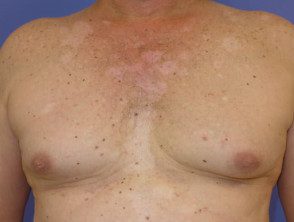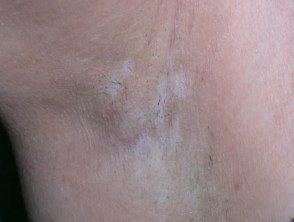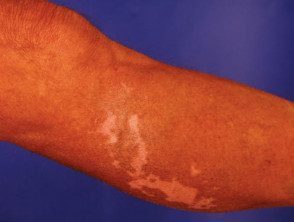What is vitiligo?
Vitiligo is common pigmentation disorder in which pigment cells (melanocytes) are destroyed by a autoimmune process. The result is the appearance of white spots that increase slowly, without any change in the texture of the skin. White patches on the skin are prone to sunburn.
What is drug-induced vitiligo?
Drug-induced vitiligo is similar to the non-drug-induced form of vitiligo and is likely due to a similar autoimmune process. Also called drug-induced leukoderma.
Drug-induced vitiligo

Induced by vemurafenib

Induced by infliximab

Induced by anticonvulsant
Who gets drug-induced vitiligo?
Drug-induced vitiligo has similar risk factors to non-drug-induced vitiligo. These risk factors include:
- Genetic factors
- Race: all races are affected
- Sex - both men and women are affected equally
- Age: Drug-induced vitiligo tends to affect older patients than those seen with non-drug-induced vitiligo.
Affected people can also develop other autoimmune disorders, especially Addison's disease, autoimmune thyroid disease (both hyperthyroidism and hypothyroidism), diabetes mellitus, pernicious anemia and alopecia areata.
A previous history of vitiligo can also make a patient more vulnerable to an extension of drug-induced pigment loss.
What Causes Drug-Induced Vitiligo?
The most common causes of drug-induced vitiligo are immunomodulatory, biological, or specific medications. These medications include:
- Current imiquimod
- Interleukin (IL) -2, IL-4 and interferon
- Tumor necrosis factor inhibitors: infliximab, adalimumab, and etanercept
- Programmed death receiver inhibitors, pembrolizumab and nivolumab, used in metastatic melanoma (15% of treated patients develop vitiligo)
- BRAF inhibitors: vemurafenib and dabrafenib
- Tyrosine kinase inhibitors: imatinib and gefitinib.
Rare cases of drug-induced vitiligo have also been reported in:
- Topical Diphencyprone and Squaric Acid
- Anticonvulsants
- Levodopa
-
Antimalarials such as hydroxychloroquine.
- Other drugs
Note: phenols that cause located Contact leukoderma, such as hydroquinone monobenzyl ether, paraphenylenediamine, and rhododendrol, can also cause generalized vitiligo in rare cases.
The mechanism of drug-induced vitiligo is uncertain and there are currently autoimmune, neural and cytotoxic theories in relation to this.
What are the clinical features of drug-induced vitiligo?
Drug-induced vitiligo has characteristics similar to non-drug-induced vitiligo, except that it tends to have a rapid onset and spread. Little white like confetti macules they are common in new places on the body. Drug-induced vitiligo produces flat patches of depigmented skin with irregular but defined edges. The areas of the body most likely to be affected are the face, elbows and knees, the back of the hands, and the genitals.
Vitiligo is more visible in dark-skinned people, and it often causes emotional stress or embarrassment, and reduces the quality of life of the affected individual.
How is drug-induced vitiligo diagnosed?
The diagnosis of drug-induced vitiligo is based on the patient's history and a careful general examination of the skin. Investigations could include:
- Wooden lamp skin examination: a wooden lamp is a hand UV lamp that can reveal the range of depigmentation
-
Dermoscopy showing white depigmented areas
-
Skin biopsy to confirm the complete loss of melanocytes in the affected skin.
How is drug-induced vitiligo treated?
the causal drug stops, when possible. Treatment options for drug-induced vitiligo include:
-
Cosmetic camouflage and sunscreen
- Phototherapy
-
Excimer To be therapy
-
Topical corticosteroids and calcineurin inhibitors.
-
Skin grafts taken normally pigmented zones
What is the outcome for drug-induced vitiligo?
Drug-induced vitiligo usually resolves when the offending drug is stopped, but the time it takes to happen can vary greatly. Vitiligo is difficult to treat.

